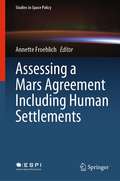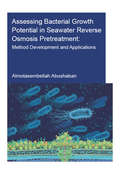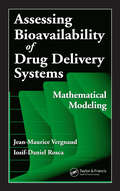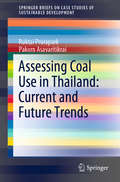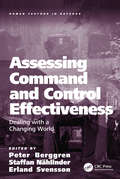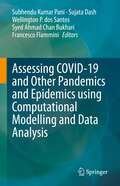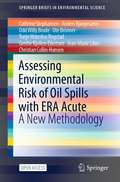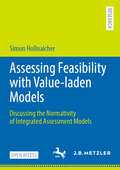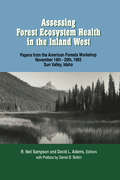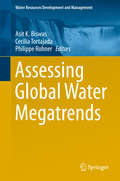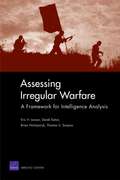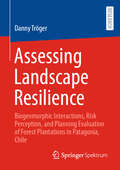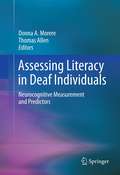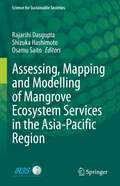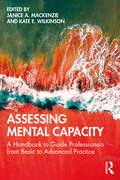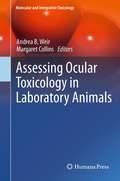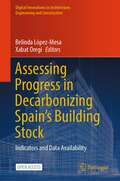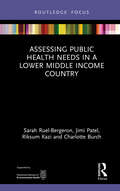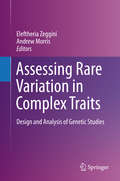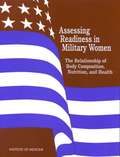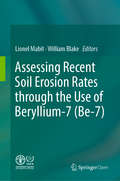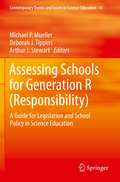- Table View
- List View
Assessing a Mars Agreement Including Human Settlements (Studies in Space Policy #30)
by Annette FroehlichThis book is dedicated to the nascent discussion of the legal aspects of human exploration and possible settlement of Mars, and provides fresh insights and new ideas in two key areas. The first one revolves around the broader aspects of current space law, such as intellectual property rights in outer space, the legal implications of contact with extra-terrestrial intelligence, legal considerations around the freedom of exploration and use, and the International Space Station agreement as a precedent for Mars. The second one focuses on the creation and management of a new society on Mars, and includes topics such as human reproduction and childbirth, the protection of human rights in privately-funded settlements, legal aspects of a Martian power grid, and criminal justice on the red planet. With multiple national space agencies and commercial enterprises focusing on Mars, it is more than likely that a human presence will be established on the red planet in the coming decades. While the foundation of international space law, laid primarily by the Outer Space Treaty, remains the framework within which humans will engage with Mars, new and unforeseen challenges have arisen, driven particularly by the rapid pace of technological advancement in recent years. To ensure that space law can keep up with these developments, a new scholarly work such as the present one is critical. By bringing together a number of fresh international perspectives on the topic, the book is of interest to all scholars and professionals working in the space field.
Assessing Accomplished Teaching: Advanced-Level Certification Programs
by National Research Council of the National AcademiesThe mission of the National Board for Professional Teaching Standards (NBPTS) is to establish “high and rigorous standards for what teachers should know and be able to do, to certify teachers who meet those standards, and to advance other education reforms for the purpose of improving student learning in American schools.” In response to a request from the U.S. Congress, the National Research Council developed a framework for evaluating programs that award advanced-level teacher certification and applied that framework in an evaluation of the impacts of the NBPTS. Specifically, this book addresses the impacts on students, teachers, and the educational system in this country. Assessing Accomplished Teaching finds that teachers who earn board certification are more effective at improving their students’ achievement than other teachers, but school systems vary greatly in the extent to which they recognize and make use of board-certified teachers. Many of the questions on the evaluation framework could not be answered because the data have not been collected, and the report makes recommendations for the kinds of research that are needed to fully evaluate the impacts of board certification by the NBPTS.
Assessing and Improving the Interpretation of Breast Images: Workshop Summary
by Sharyl J. NassMillions of women undergo screening mammography regularly with the hope of detecting breast cancer at an earlier and more curable stage. But the ability of such screening to accurately detect early cancers depends on the quality of mammography, including high-quality image acquisition and interpretation. To help ensure the quality of mammography, Congress passed the Mammography Quality Standards Act (MQSA) in 1994 and last reauthorized it in 2004. In advance of its expected reauthorization in 2007, Congress requested a consensus study from the Institute of Medicine (IOM) recommending ways to improve the quality of mammography, with an emphasis on image interpretation. The resulting report, Improving Breast Imaging Quality Standards, highlighted the need to decrease variability in mammography interpretation in the United States and identified gaps in the evidence needed to develop best practices. The consensus committee found that mammography interpretation remained quite variable, and that this variability limited the full potential of mammography to reduce breast cancer mortality by detecting breast cancers at an early stage. In May 2015, the IOM convened a workshop to address this issue. The participants discussed challenges in the delivery of high-quality mammography, the impact of training and experience on interpretive performance, how best to measure interpretive performance, and the potential impact of new technologies and supplemental imaging on interpretation of breast screening and diagnostic images. Assessing and Improving the Interpretation of Breast Images summarizes the presentations and discussions from this workshop.
Assessing Bacterial Growth Potential in Seawater Reverse Osmosis Pretreatment: Method Development and Applications (IHE Delft PhD Thesis Series)
by Almotasembellah AbushabanSeawater desalination is increasingly being used as a means to augment freshwater supplies in regions with high water stress, and reverse osmosis is increasingly the technology of choice because of the low energy consumption. However, seawater reverse osmosis (SWRO) systems suffer from various types of fouling, which can increase energy consumption and the use of chemicals during SWRO operation. In practice, pre-treatment systems are put in place to reduce the particulate and biological fouling potential of SWRO feed water. However, simple, reliable and accurate methods to assess the extent to which biological fouling potential is reduced during pre-treatment are not available for seawater. This research developed a new method to measure bacterial growth potential (BGP) using the native bacterial consortium in seawater. New reagents to extract and detect ATP in microbial cells were specifically developed for seawater. The new lysis and detection reagents overcame the salt interference in seawater and allow low detection of total ATP, free ATP and microbial ATP in seawater. Incorporating a filtration step further increased the sensitivity of the method six fold, enabling ATP detection of ultra-low levels of microbial ATP in seawater. The newly developed ATP-based BGP method was applied to monitor and assess the pre-treatment of five full-scale seawater desalination plants around the world. A good correlation was observed between BGP measured in SWRO feed water and the pressure drop increase in the SWRO systems, suggesting the applicability of using the ATP-based BGP method as a biofouling indicator in SWRO. Furthermore, a safe level of BGP ( In the future, on-line monitoring of BGP in SWRO feed water may further reduce the consumption of chemicals and energy and improve the overall sustainability of seawater desalination by reverse osmosis.
Assessing Bioavailablility of Drug Delivery Systems: Mathematical Modeling
by Jean-Maurice Vergnaud Iosif-Daniel RoscaExploring how to apply in vitro/in vivo correlations for controlled release dosage forms, Bioavailability of Drug Delivery Systems: Mathematical Modeling clearly elucidates this complex phenomena and provides a guide for the respective mathematical modeling. The book introduces mathematical modeling methods for calculating the profiles of plasma le
Assessing Coal Use in Thailand: Current and Future Trends (SpringerBriefs on Case Studies of Sustainable Development)
by Ruktai Prurapark Pakorn AsavaritikraiThis book highlights Thailand’s growing demand for clean energy from coal. The main source of energy for electricity production in Thailand (70%) is currently natural gas. However, natural gas extraction remains limited, resulting in an increasing need to import natural gas from other countries, which in turn leads to rising prices and unstable supplies. As such, coal energy is essential for industrial use and electricity production in Thailand. The book discusses the importance of developing and implementing clean technologies for coal. It also argues that collaborations between the government, private sector and the public are vital to achieving a mutual understanding and acceptance of coal energy and clean technologies, as well as a reduction in harmful emissions.
Assessing Command and Control Effectiveness: Dealing with a Changing World (Human Factors in Defence)
by Peter Berggren Staffan Nählinder Erland SvenssonAssessing Command and Control Effectiveness: Dealing with a Changing World offers a description of the current state of Command and Control (C2) research in imperfect settings, showing how a research process should assess, analyse and communicate results to the development cycle of methods, work, manning and C2-technology. Special attention is given to the development of C2 research methods to meet the current and coming needs. The authors also look forward towards a future where effective assessment of C2 abilities are even more crucial, for instance in agile organisations. The purpose of the C2 research is to improve the process and make it more effective while still saving time and money. Research methods have to be chosen carefully to be effective and simple, yet provide results of high quality. The methodological concerns are a major consideration when working under such circumstances. Furthermore, there is often a need for a swift iterative development cycle, and thus a demand to quickly deliver results from the research process. This book explains how field research experimentation can be quick, simple and effective, being able to draw valid conclusions even when sample sizes are small and resources are limited, collecting empirical data using measures and procedures that are minimally intrusive.
Assessing COVID-19 and Other Pandemics and Epidemics using Computational Modelling and Data Analysis
by Subhendu Kumar Pani Sujata Dash Wellington P. dos Santos Syed Ahmad Chan Bukhari Francesco FlamminiThis book comprehensively covers the topic of COVID-19 and other pandemics and epidemics data analytics using computational modelling. Biomedical and Health Informatics is an emerging field of research at the intersection of information science, computer science, and health care. The new era of pandemics and epidemics bring tremendous opportunities and challenges due to the plentiful and easily available medical data allowing for further analysis. The aim of pandemics and epidemics research is to ensure high-quality, efficient healthcare, better treatment and quality of life by efficiently analyzing the abundant medical, and healthcare data including patient’s data, electronic health records (EHRs) and lifestyle. In the past, it was a common requirement to have domain experts for developing models for biomedical or healthcare. However, recent advances in representation learning algorithms allow us to automatically learn the pattern and representation of the given data for the development of such models. Medical Image Mining, a novel research area (due to its large amount of medical images) are increasingly generated and stored digitally. These images are mainly in the form of: computed tomography (CT), X-ray, nuclear medicine imaging (PET, SPECT), magnetic resonance imaging (MRI) and ultrasound. Patients’ biomedical images can be digitized using data mining techniques and may help in answering several important and critical questions related to health care. Image mining in medicine can help to uncover new relationships between data and reveal new and useful information that can be helpful for scientists and biomedical practitioners. Assessing COVID-19 and Other Pandemics and Epidemics using Computational Modelling and Data Analysis will play a vital role in improving human life in response to pandemics and epidemics. The state-of-the-art approaches for data mining-based medical and health related applications will be of great value to researchers and practitioners working in biomedical, health informatics, and artificial intelligence..
Assessing Environmental Risk of Oil Spills with ERA Acute: A New Methodology (SpringerBriefs in Environmental Science)
by Cathrine Stephansen Anders Bjørgesæter Odd Willy Brude Ute Brönner Tonje Waterloo Rogstad Grethe Kjeilen-Eilertsen Jean-Marie Libre Christian Collin-HansenThis open access book introduces readers to a new methodology for assessing the risks to the marine environment following accidental oil spills. The methodology will soon be implemented on the Norwegian Continental Shelf and will be complemented by guidelines for its use in a regulatory framework. The brief book is intended to provide international readers with a basic grasp of what the ERA Acute methodology consists of, what its applications are, and the underlying impact and restoration models used in its development. The content is divided into three main parts: an introduction and overview of risk management applications for generalists at the management level, a model overview for generalist scientists, and a more detailed final section for risk assessment professionals, which presents the results of the validation and sensitivity testing.
Assessing Feasibility with Value-laden Models: Discussing the Normativity of Integrated Assessment Models
by Simon HollnaicherIn this Open-Access-book, the author investigates the value dimension of Integrated Assessment Models and their application to questions of feasibility. Integrated models provide a quantified representation of the interaction between the socio-economic system with the climate and serve as a pivotal tool at the intersection of climate science, policymakers, and society. This book critically examines how IAMs approach the concept of feasibility. It unpacks the value assumptions embedded within integrated modeling, critiques the implicit normativity of these models, and proposes principles for responsibly managing value judgments in scientific advice. Arguing for a thick conception of feasibility—one that integrates key normative dimensions—it highlights the gap between conceptual discussions of feasibility and the scientific practices that inform feasibility assessments. Addressed to both philosophers and integrated modelers, this book sheds light on the implicit values shaping our collective visions for the future.
Assessing Forest Ecosystem Health in the Inland West
by David L. AdamsInland West, their historical origins, assessments of available management tools, and analyses of the various choices available to policymakers. Its goal is to help people understand the Inland West forests so that public policies can reflect a constructive and realistic framework in which forests can be managed for sustained health. This resource is the product of a scientific workshop where 35 participants, including scientists, resource managers, administrators, and environmentalists, addressed the forest health problem in the Inland West. Synthesis chapters integrate the diverse knowledge and experience which participants brought to the workshop. They identify and link together many of the ecological, social, and administrative conditions which have created the forest health problem in the West. The book is unique in that it reflects a process that fostered the use of academic research, field realities, and industrial knowledge to define an interdisciplinary problem, establish rational policy objectives, and set-up “do-able” management approaches.The following topics are analyzed: Assessing forest ecosystem health in the Inland West Historical and anticipated changes in forest ecosystems in the Inland West Defining and measuring forest health Historical range of variability as a tool for evaluating ecosystem change Administrative barriers to implementing forest health problems Economic and social dimensions of the forest health problem Fire management Ecosystem and landscape management
Assessing Global Water Megatrends (Water Resources Development and Management)
by Asit K. Biswas Cecilia Tortajada Philippe RohnerThis book highlights what are likely to be the future megatrends in the water sector and why and how they should be incorporated to improve water governance in the coming decades. In this first ever book on megatrends for the water sector, 22 leading world experts from different disciplines representing academia, business, government, national and international organisations discuss what the major megatrends of the future are and how they will radically change water governance in the coming decades.
Assessing Irregular Warfare
by Eric V. Larson Derek Eaton Brian Nichiporuk Thomas S. SzaynaProvides an analytic framework and procedure for the intelligence analysis of irregular warfare (IW) environments that can serve as the basis for IW intelligence curriculum development efforts. Defines IW in terms of two stylized situations: population-centric (such as counterinsurgency) and counterterrorism. Provides a detailed review of IW-relevant defense policy and strategy documents and a list of relevant doctrinal publications.
Assessing Landscape Resilience: Biogeomorphic Interactions, Risk Perception, and Planning Evaluation of Forest Plantations in Patagonia, Chile
by Danny TrögerThis book examines the extent to which exotic pine plantations are a suitable strategy for maintaining the essential functions, structures, processes and identity of the Patagonian landscape over time. To this end, it integrates three empirical studies with inter- and transdisciplinary approaches under the theoretical framework of landscape resilience. The first study analyses the biogeomorphic interactions of different land uses and their relevance for soil conservation and landslide mitigation. The second study examines perceptions of natural hazards and focuses on networks of human and non-human actors that maintain landscape resilience. The results of these two studies are incorporated into the planning evaluation of land zoning and alternative strategies are developed, inspired by normative polycentric governance. It is concluded that Pinus plantations partially fulfil their ecological objectives of erosion control and landslide mitigation. However, their performance lags behind that of secondary forests with native species and they create new risks such as reduced biodiversity, increased risk of wildfires and conflicts with local identity. The book concludes with new research questions of trans-regional importance.
Assessing Literacy in Deaf Individuals: Neurocognitive Measurement and Predictors
by Donna Morere Thomas Allen<P>Humans' development of literacy has been a recent focus of intense research from the reading, cognitive, and neuroscience fields. But for individuals who are deaf--who rely greatly on their visual skills for language and learning--the findings don't necessarily apply, leaving theoretical and practical gaps in approaches to their education. <P>Assessing Literacy in Deaf Individuals: Neurocognitive Measurement and Predictors narrows these gaps by introducing the VL2 Toolkit, a comprehensive test battery for assessing the academic skills and cognitive functioning of deaf persons who use sign language. Skills measured include executive functioning, memory, reading, visuospatial ability, writing fluency, math, and expressive and receptive language. Comprehensive data are provided for each, with discussion of validity and reliability issues as well as ethical and legal questions involved in the study. And background chapters explain how the Toolkit was compiled, describing the procedures of the study, its rationale, and salient characteristics of its participants. This notable book: <br>Describes each Toolkit instrument and the psychometric properties it measures. <br>Presents detailed findings on test measures and relationships between skills. <br>Discusses issues and challenges relating to visual representations of English, including fingerspelling and lipreading. <br>Features a factor analysis of the Toolkit measures to identify underlying cognitive structures in deaf learners. <br>Reviews trends in American Sign Language assessment. <br>Assessing Literacy in Deaf Individuals is an essential reference for researchers, graduate students, clinicians, and other professionals working in the field of deafness and deaf education across in such areas as clinical child and school psychology, audiology, and linguistics.
Assessing, Mapping and Modelling of Mangrove Ecosystem Services in the Asia-Pacific Region (Science for Sustainable Societies)
by Rajarshi Dasgupta Shizuka Hashimoto Osamu SaitoThis book presents the state-of-the-art of knowledge in assessing, mapping, and modeling mangrove ecosystem services and outlines various scientific tools and techniques, including environmental scenario-building, spatial and econometric modelling to understand the fluctuations and future availability of mangrove ecosystem services. The book also highlights the current gaps and measures in policy planning and outlines the avenues for capacity building. Through case studies and thematic reviews, the book plans to cater to a wide range of audiences, including students, researchers, and decision-makers at various levels involved in mangrove conservation and land use optimization for sustainable and resilient development. This book is particularly useful to researchers and students in the field of landscape and spatial ecology, coastal zone management, ecosystem services, and resilience planning. It is also a must-read for policymakers, conservators, coastal zone managers, foresters, and general administrators in understanding the current and future roles of mangroves in ecosystem-based adaptation through informed decision-making.
Assessing Mental Capacity: A Handbook to Guide Professionals from Basic to Advanced Practice
by Janice A. Mackenzie Kate E. WilkinsonThis practical, how-to handbook provides essential resources to help clinicians and other professionals assess mental capacity in key decisions. The book illustrates the basics of capacity assessments before discussing a variety of complex issues of which professionals will need to be aware. Offering expertise from a multi-disciplinary perspective, the book provides hands-on coverage of mental capacity law (concentrating on England and Wales). This book is accompanied by online resources including semi-structured interviews and a multi-disciplinary team (MDT) questionnaire which can be downloaded and used for clinical cases, as well as further examples, information and tips. Please visit www.assessingcapacity.com. Chapters are written by a variety of different professionals with extensive experience in the assessment of mental capacity. Coverage includes: Explanations of mental capacity law and how to put it into practice across a range of settings, services and populations A "how to" approach for administering assessments of mental capacity both for professionals who are new to the area and for more experienced professionals Information on practical aspects of assessing mental capacity for commonly occurring decisions and for more specialist and complex decisions Consideration of the best interests process and Liberty Protection Safeguards (LPS). With easily accessible information, case studies, examples from case law and internationally relevant discussions on ethical issues, this is the perfect companion to help busy professionals understand complex concepts relating to mental capacity.
Assessing Ocular Toxicology in Laboratory Animals (Molecular and Integrative Toxicology)
by Margaret Collins Andrea B WeirOcular toxicity is routinely assessed in toxicology studies conducted for regulatory purposes. Ocular anatomy and physiology and the assessment of ocular toxicity itself can be challenging to scientists involved in the safety assessment of pharmaceuticals, pesticides and other agents. Anatomical and physiological differences between species can impact the nature of ocular effects observed following intended or unintended exposure of ocular tissues to xenobiotics. Ocular Toxicity in Laboratory Animals provides a concise reference addressing ocular anatomy and physiology across species that will enhance the design and interpretation of toxicology studies conducted for regulatory purposes. The book provides an overview of routine and advanced techniques that are used to assess ocular toxicity including slit lamp biomicroscopy, indirect ophthalmoscopy, electrophysiology and imaging methods for the anterior and posterior segments of the eye. Additionally, the book defines the regulatory expectations for pharmaceuticals intended to treat ocular diseases and for other non-pharmaceutical regulated chemicals. With contributions from experts in the field, Ocular Toxicity in Laboratory Animals is an authoritative, accessible guide for toxicologists and other scientists involved in conducting toxicology studies for regulatory purposes and/or reviewing data from such studies.
Assessing Pain and Communication in Disorders of Consciousness (Neuropsychological Rehabilitation: A Modular Handbook)
by Steven Laureys Camille ChatelleRecent advances in medicine for resuscitation and care have led to an increased number of patients that survive severe brain damage but who are poorly responsive and non-communicative at the bedside. This has led to a striking need to better characterize, understand, and manage this population who present a real challenge for the assessment of pain and for planning treatment. This edited collection provides clinicians with a guide to recent developments in research on pain perception and assessment, and the detection of consciousness and communication in patients with disorders of consciousness (DOC). With contributions from leading global researchers, the book gives an overview of issues concerning the assessment of pain. It also covers the development of suitable tools both to improve pain management and to detect consciousness and communication in these patients, to influence their prognosis and treatment, and their quality of life. Methodological and ethical issues concerning the implication for future research are also considered. The book will be an invaluable guide for clinicians, medics and therapists working in rehabilitation and acute care, particularly in the demanding field of pain perception, pain assessment and detection of consciousness and communication in patients with DOC. It will also be useful for students and researchers in neuropsychology and medical sciences.
Assessing Progress in Decarbonizing Spain’s Building Stock: Indicators and Data Availability (Digital Innovations in Architecture, Engineering and Construction)
by Belinda López-Mesa Xabat OregiThis open access book delves into the topic of monitoring the effectiveness of building renovation policies within the European Union (EU) using indicators. Given the substantial environmental impact of existing buildings on energy consumption and greenhouse gas emissions, decarbonizing them is imperative for achieving climate neutrality in Europe. The use of indicators for monitoring decarbonization progress and evaluating policies emerges as a valuable tool, ensuring the efficiency, effectiveness, and alignment of building renovation policies with broader sustainability and climate objectives. Additionally, this approach facilitates evidence-based decision-making, promotes accountability by Member States (MSs), supports the realization of long-term goals, and actively involves the public in these vital initiatives. The European Commission is actively engaged in this realm, releasing a framework of optional indicators in 2019 and subsequently refining it during the review of the Energy Performance of Buildings Directive. The evolving framework seeks to encompass both mandatory and optional indicators, posing greater challenges for EU MSs in monitoring the impact of their national building renovation policies and the progress of decarbonizing their building stocks. This book offers insights into these developing indicator frameworks, assesses the availability and quality of data in the case of Spain, and suggests areas of improvement and innovative approaches using emerging technologies to enhance data. The target audience includes diverse stakeholders such as central government administrations, regional and municipal authorities, data-collecting institutions, urban planners, researchers, and citizens interested in comprehending the impact of building renovation. By addressing this broad audience, the book aims to foster a more inclusive and well-informed discussion on building renovation and the decarbonization of the European building stock.
Assessing Public Health Needs in a Lower Middle Income Country (Routledge Focus on Environmental Health)
by Sarah Ruel-Bergeron Jimi Patel Riksum Kazi Charlotte BurchThis book demonstrates a methodology for assessing public health needs in communities experiencing environmental sanitation inadequacies. Centring on a case study of the Republic of Cameroon, the findings represent the starting point of a campaign to implement a comprehensive water and sanitation infrastructure through advocacy, housing improvements, and new service chains. Based on an assessment report undertaken by ARCHIVE Global, an international non-profit organization focusing on the link between health and housing, this book: Explores and establishes a causal relationship between the built environment and its impacts on public health Uses the United Nations’ Sustainable Development Goals as a benchmark for highlighting issues and challenges with sanitation infrastructure projects Provides lessons for communities around the world facing environmental health issues similar to those Cameroon’s Idenau Municipality deals with. This book is intended for environmental health professionals, academics and policymakers, be they domestic to the African region or multinational practitioners. Donor countries, the likes of the United States and European nations, will also value the book’s advocacy for interventions in the built environment and current public health impacts.
Assessing Rare Variation in Complex Traits: Design and Analysis of Genetic Studies
by Eleftheria Zeggini Andrew MorrisThis book is unique in covering a wide range of design and analysis issues in genetic studies of rare variants, taking advantage of collaboration of the editors with many experts in the field through large-scale international consortia including the UK10K Project, GO-T2D and T2D-GENES. Chapters provide details of state-of-the-art methodology for rare variant detection and calling, imputation and analysis in samples of unrelated individuals and families. The book also covers analytical issues associated with the study of rare variants, such as the impact of fine-scale population structure, and with combining information on rare variants across studies in a meta-analysis framework. Genetic association studies have in the last few years substantially enhanced our understanding of factors underlying traits of high medical importance, such as body mass index, lipid levels, blood pressure and many others. There is growing empirical evidence that low-frequency and rare variants play an important role in complex human phenotypes. This book covers multiple aspects of study design, analysis and interpretation for complex trait studies focusing on rare sequence variation. In many areas of genomic research, including complex trait association studies, technology is in danger of outstripping our capacity to analyse and interpret the vast amounts of data generated. The field of statistical genetics in the whole-genome sequencing era is still in its infancy, but powerful methods to analyse the aggregation of low-frequency and rare variants are now starting to emerge.
Assessing Readiness in Military Women: The Relationship of Body Composition, Nutrition, and Health
by Committee on Body Composition Nutrition Health of Military WomenU.S. military personnel are required to adhere to standards of body composition, fitness, and appearance to achieve and maintain readiness--that is, the maintenance of optimum health and performance so they are ready for deployment at any moment. In 1992, the Committee on Military Nutrition Research reviewed the existing standards and found, among other things, that the standards for body composition required for women to achieve an appearance goal seemed to conflict with those necessary to ensure the ability to perform many types of military tasks. This report addresses that conflict, and reviews and makes recommendations about current policies governing body composition and fitness, as well as postpartum return-to-duty standards, Military Recommended Dietary Allowances, and physical activity and nutritional practices of military women to determine their individual and collective impact on the health, fitness, and readiness of active-duty women.
Assessing Recent Soil Erosion Rates through the Use of Beryllium-7 (Be-7)
by Lionel Mabit William BlakeThis open access book is the first comprehensive guideline for the beryllium-7 (Be-7) technique that can be applied to evaluate short-term patterns and budgets of soil redistribution in agricultural landscapes. While covering the fundamental and basic concepts of the approach, this book distinguishes itself from other publications by offering step-by-step instructions on how to use this isotopic technique effectively. It covers experimental design considerations and clear instruction is given on data processing. As accurate laboratory measurement is crucial to ensure successful use of Be-7 to investigate soil erosion, a full chapter is devoted to its specific determination by gamma spectrometry. This open access contribution further describes new developments in the Be-7 technique and includes a concluding chapter highlighting its potential benefits to support the implementation of area-wide soil conservation policy.
Assessing Schools for Generation R: A Guide for Legislation and School Policy in Science Education (Contemporary Trends and Issues in Science Education #41)
by Michael P. Mueller Deborah J. Tippins Arthur J. StewartToday's youth will face global environmental changes, as well as complex personal and social challenges. To address these issues this collection of essays provides vital insights on how science education can be designed to better engage students and help them solve important problems in the world around them. Assessing Schools for Generation R (Responsibility) includes theories, research, and practices for envisioning how science and environmental education can promote personal, social, and civic responsibility. It brings together inspiring stories, creative practices, and theoretical work to make the case that science education can be reformed so that students learn to meaningfully apply the concepts they learn in science classes across America and grow into civically engaged citizens. The book calls for a curriculum that equips students with the knowledge, skills, attitudes and values to confront the complex and often ill-defined socioscientific issues of daily life. The authors are all experienced educators and top experts in the fields of science and environmental education, ecology, experiential education, educational philosophy, policy and history. They examine what has to happen in the domains of teacher preparation and public education to effect a transition of the youth of America. This exciting, informative, sophisticated and sometimes provocative book will stimulate much debate about the future direction of science education in America, and the rest of the world. It is ideal reading for all school superintendents, deans, faculty, and policymakers looking for a way to implement a curriculum that helps builds students into responsible and engaged citizens.
